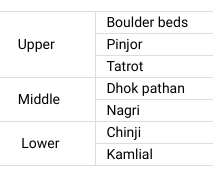Neogene
Neogene of Himalayas
Neogene of India has been deposited in Outer Himalayas. It consisted of two main successions, Siwalik supergroup and Karewa formation.
Siwalik ranges are located in the outer Himalayas region and represents the Miocene - Pliocene sediments. This supergroup is very important for the study of vertebrates palaeontology as fossils of homo sapiens, horse, giraffe, elephant and buffalo etc are abundant in its sediments.
Siwalik ranges are located in the outer Himalayas region and represents the Miocene - Pliocene sediments. This supergroup is very important for the study of vertebrates palaeontology as fossils of homo sapiens, horse, giraffe, elephant and buffalo etc are abundant in its sediments.
Evolution
After the collision of Indian plate with Eurrasian plate, the crust became thick and high mountains raised of flysch sediments. The streams which headed down from these peaks deposited the molasse sediments.
Characteristics of Siwalik supergroup
- Age is mid miocene to mid pliocene.
- The succession is divided into 3 parts.
- Each of 3 parts have one characteristic mineral. Lowest have staurolite, middle have kyanite and upper have hornblende.
- The succession shows upward increase in size of sediments. Lowest are the shale and silt while upper parts have conglomerates and boulders.
- It has abundant vertebrates' fossils.
- Depositional environment was fluvial, lacustrine and marshy.
Lithology & Stratigraphy
Siwaliks are deposited on Murre formation and underlies the Karewa formation. Lower Siwaliks
It mostly consisted of shale and silt. Deposited in lacustrine environment. Characteristic mineral is staurolite.
Fossils : Hypoboops, Listriodon
Middle Siwaliks
Dominated by silt and sand. Depositional environment is marshy. Large size grains were carried by the high energy rivers from Himalayas. Characteristic mineral is kyanite.
Fossils : Nagri formation have Hipparian, Matodoon and Ramapithecus. Dhok pathan has Stegodon, mastodoon and Girrafoid.
Upper Siwaliks
Sand and conglomerates are common. Upper portion have Boulder beds where it has gradational contact with Karewa formation. These were deposited in high energy fluvial environment. Characteristic mineral is hornblende.
Fossils : Elephus, Equus, camelus.
__________
Karewa Formation
Karewa formation deposited durin mid pliocene to early pliestocene. It was deposited in Glacio - fluvial environment. The lithology is mostly of sand silt and till with lignite coal seams.






Post a Comment